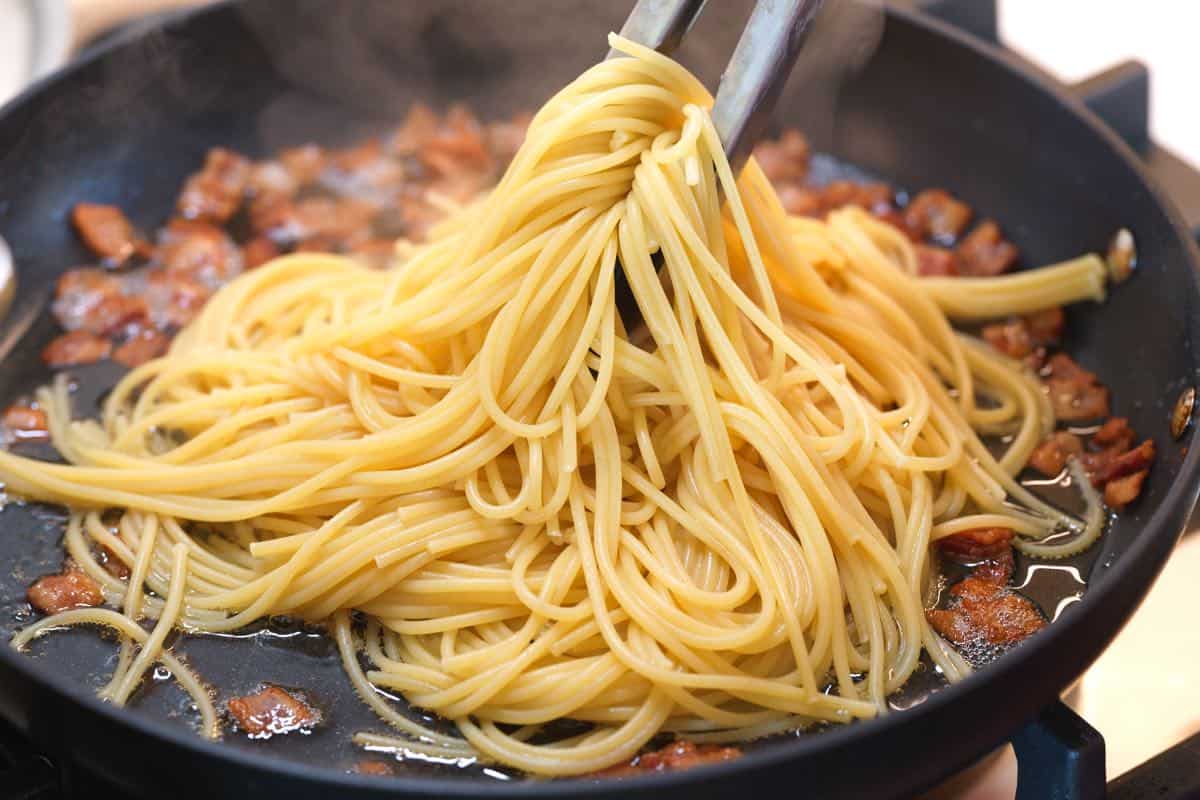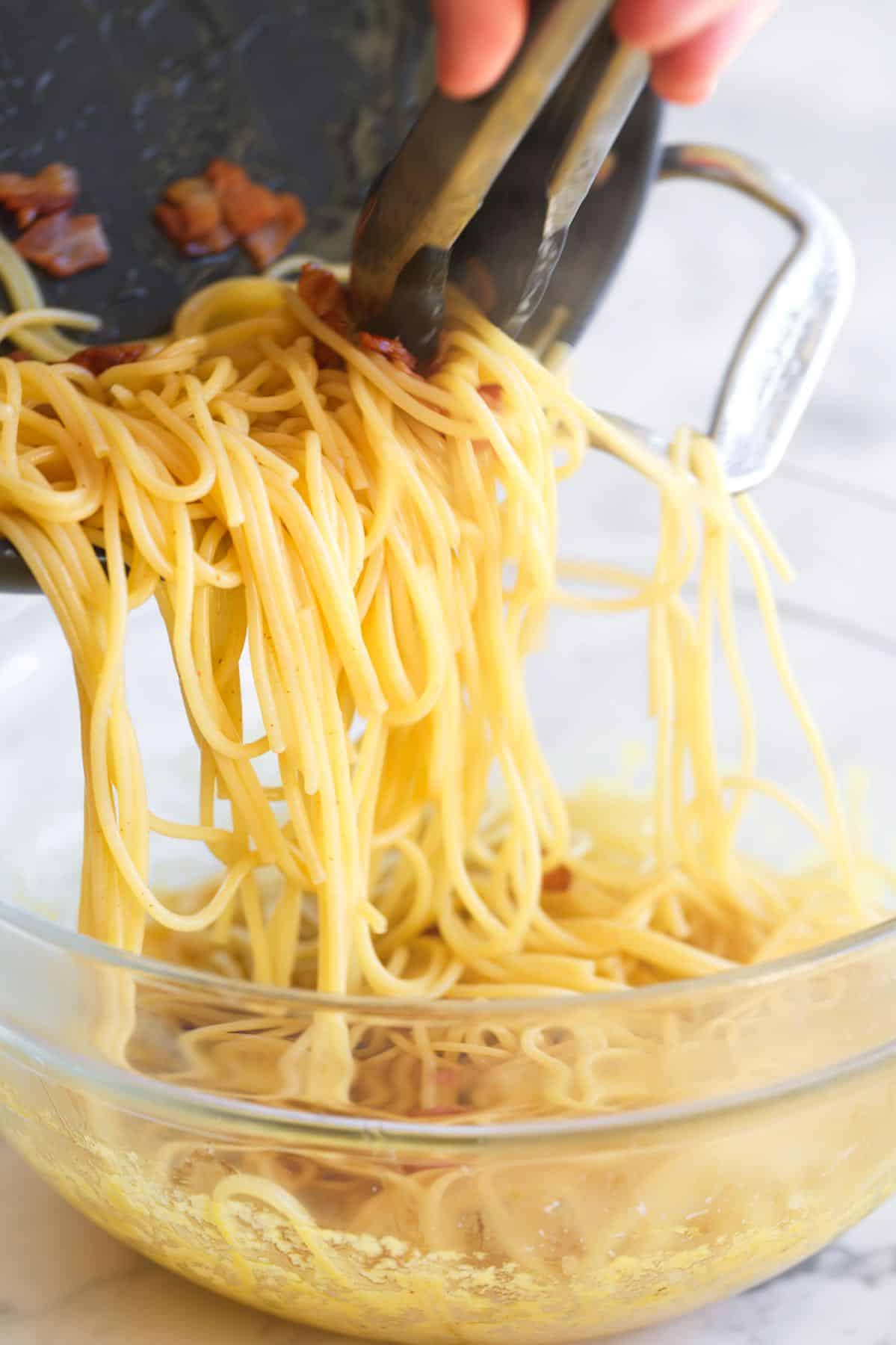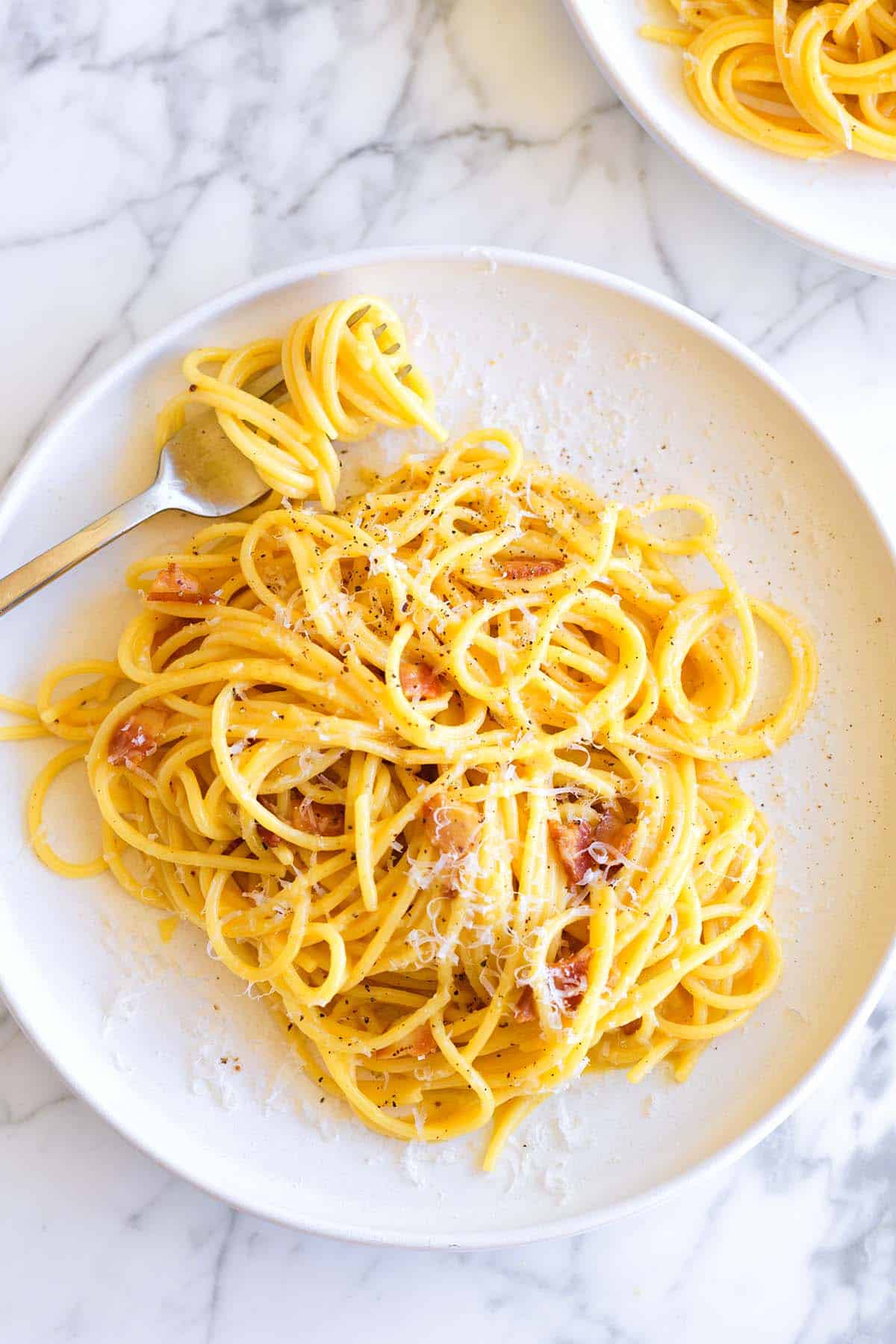This is my favorite way to make incredible carbonara at home! Our recipe does not use cream but instead makes it with authentic ingredients and relies on cured pork, eggs, cheese, and starchy pasta water to make our silky carbonara sauce. You’ll love this one!
Every time I make pasta carbonara, I fall in love all over again. It’s a creamy classic Italian pasta dish with a short ingredient list that takes about 15 minutes and takes you to creamy pasta heaven. We’re leaning on classic carbonara principles for this recipe, which means there’s no cream.
The real secret to why carbonara is so darn good is eggs. You’ll mix eggs and egg yolks with cheese, rendered fat from cured pork (like bacon, guanciale, or pancetta), and starchy pasta water. The combination turns into a rich and silky sauce, but not so much you feel weighed down. Excellent carbonara is actually pretty light on its feet, and I’ve shared everything you need to know to make it below! For more pasta recipes, see our Italian meatballs with the best sauce, weeknight spaghetti, baked ziti, and brown butter pasta with egg.
Key Ingredients
- Pork: You want a form of cured, fatty pork like guanciale (most traditional), pancetta, or thick-cut bacon (easiest to find). We will render this in a skillet, which adds flavor to our dish, and since you’ll have some rendered fat, it makes our sauce much creamier after mixing it with the eggs and cheese.
- Pasta: Use your favorite long pasta noodles. My go-to is spaghetti, but bucatini, which looks like spaghetti with a hole down the middle, is also lovely. If you are up for it, carbonara made with homemade pasta is amazing!
- Room Temperature Eggs: There’s no cream in carbonara. Instead, we combine egg and egg yolk with the rendered fat and some starchy pasta water to make the sauce silky and creamy. The eggs heat up but likely don’t hit a temperature that makes them fully cooked (similar to when making homemade tiramisu). We are looking for a creamy, emulsified sauce, not a fully cooked scrambled egg texture. If you are concerned about raw eggs, use pasteurized eggs (common at most grocery stores). If you are still worried, try fettuccine alfredo instead, which has no eggs and uses butter and cheese for the sauce. Note: If your eggs are straight from the fridge, you can warm them up quickly by adding them (in their shells) to a bowl of warm water and leaving them for a few minutes.
- Cheese: I use Parmigiano-Reggiano, but Pecorino-Romano is also excellent in this dish. Some recipes do half and half, which would also be lovely. For the best results, use a fine grater to grate the cheese, and skip the pre-grated parmesan, as it doesn’t melt down as well into a silky carbonara sauce.
- Salt and Black Pepper: For perfectly seasoned pasta, you want to season your pasta water, which will season the pasta itself, and since we use some of that starchy water to bring our sauce together, it will also season the sauce. Fresh black pepper is pretty common in carbonara, and for good reason. Its hint of spice really cuts through the sauce. I prefer fresh ground black pepper for this.
How to Make Carbonara
Start by bringing a large pot of salted water to a boil. If using dried pasta, add it to the boiling water now. Note that fresh or homemade pasta cooks much faster, so if you’re using fresh pasta, wait to add it to the water until just before the pork is almost finished rendering.
While the pasta cooks (or while you wait to add the fresh pasta), you can render the pork (bacon, guanciale, or pancetta). Add the pork to a skillet with a bit of olive oil and cook over medium-low heat. The pork should be sizzling gently, not browning too quickly. Cook until the fat renders and the pork is still slightly chewy in the center (not crunchy/crispy).
If your pork renders before the pasta is ready, simply turn off the heat and set it aside. When the pasta is just finishing up, reheat the pork and its rendered fat over low heat.
Now, prepare the bowl you’ll use for the sauce. A warm bowl helps the sauce emulsify properly. Fill a serving or mixing bowl with hot water and let it sit to the side.
When the pasta is ready, save 3/4 cup of the pasta water for later. Then, drain the pasta and toss it into the skillet over low heat with the rendered pork and its fat. Toss well for about 1 minute.

Now, for the carbonara sauce! Remember that bowl with hot water? Pour out the hot water and dry the bowl thoroughly with a clean kitchen towel. Add the cooked pasta, rendered pork, and its fat to the warm, dry bowl.


Quickly whisk in the egg and cheese mixture, tossing constantly to combine. The residual heat from the pasta and bowl will help the sauce become smooth and cling to the pasta. If it’s too thick, add the reserved pasta water, a tablespoon at a time, and continue to toss until you reach the desired consistency.
As a final step, I like to taste it, and then adjust the seasoning with salt and pepper (usually not needing to do much). Then, serve immediately so it’s warm, topped with freshly grated Parmesan cheese. Yum!


Pasta Carbonara
-
PREP
-
COOK
-
TOTAL
Our go-to carbonara recipe is a family favorite! Carbonara relies on eggs for its creamy texture. We want to avoid overheating them. We want a smooth, emulsified sauce, not scrambled eggs! Because of this, we don’t make the sauce over direct heat; instead, we use a bowl that’s been warmed with hot water. This gentle warmth makes the eggs thicken without curdling, creating the perfect creamy carbonara sauce. For best results, start with room temperature eggs. If your eggs are cold from the fridge, place them (in their shells) in a bowl of warm water for a few minutes before you begin.
4 Servings
You Will Need
12 ounces (340g) spaghetti or bucatini pasta
2 large eggs at room temperature
2 large egg yolks at room temperature
2 ounces (56g) finely grated Parmigiano-Reggiano or Pecorino Romano cheese, 1 packed cup, plus more for serving
1 tablespoon extra-virgin olive oil
4 ounces (113g) thick-cut bacon, pancetta, or guanciale, 1/4-inch thick pieces or cubes
1/2 teaspoon fresh ground black pepper
Salt for cooking the pasta
Directions
1Cook Pasta: Bring a pot of salted water to a boil. Add the pasta and cook until al dente (tender, with a nice chew). I add 1 tablespoon of salt to the pasta water. If you’re using fresh pasta, wait to add it to the water until just before the bacon is almost finished rendering.
2Prepare Egg Mixture: In a medium bowl, whisk 2 whole eggs, 2 egg yolks, 2 ounces grated Parmigiano-Reggiano, 1/2 teaspoon black pepper, and a pinch of salt. Set aside.
3Render Bacon: Heat 1 tablespoon of olive oil in a wide skillet over medium heat. Add the bacon (or pancetta or guanciale) and cook, stirring occasionally, until the fat renders and the bacon begins to crisp but still has a slight chew, 5 to 6 minutes. Turn off the heat, and set the skillet aside until the pasta is ready. Just before the pasta is done, reheat the bacon and rendered fat in the skillet over low heat.
4Prepare Bowl: Fill a large bowl with hot water and set aside. You will toss the pasta and sauce together in this bowl later on.
5Add Pasta to Skillet: Set aside 3/4 cup of hot pasta water. Then, drain the pasta and add it to the skillet over low heat. Toss the pasta around the skillet for about 1 minute.
6Create the Sauce: Empty the bowl of hot water and wipe it dry. Transfer the hot pasta, bacon, and all the rendered fat from the skillet into the bowl, then add the egg and cheese mixture. Toss well to combine, adding a splash or two of the reserved pasta water if you need to thin the sauce so it is creamy.
7Taste and season with salt and additional pepper as needed. Divide between dishes and dust with more Parmigiano-Reggiano and black pepper on top.
Adam and Joanne’s Tips
- Room temperature eggs: For best results, start with room temperature eggs. If your eggs are cold from the fridge, place them (in their shells) in a bowl of warm water for a few minutes before you begin.
- Seasoning your pasta water: I use 1 tablespoon of salt. If you’re unsure, taste the water—it should taste pleasantly salty, like seawater.
- Grating the cheese: I use a fine microplane grater to grate the cheese for this recipe. The super fine cheese melts into the sauce so nicely. Since it’s so fluffy, it fills a measuring cup quickly, so to measure it, I lightly push the cheese into the cup to pack it down a bit.
- The idea for using a warm bowl to make carbonara came from Ian Fisher of the NY Times.
- The nutrition facts provided below are estimates.
Nutrition Per Serving
Serving Size
3 ounces, 4 servings total
/
Calories
586
/
Total Fat
24.5g
/
Saturated Fat
8.2g
/
Cholesterol
215.9mg
/
Sodium
631.2mg
/
Carbohydrate
66.5g
/
Dietary Fiber
2.8g
/
Total Sugars
2.7g
/
Protein
23.2g


